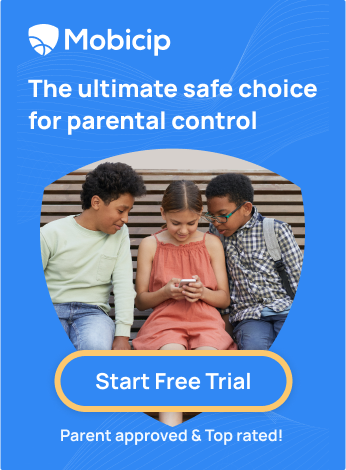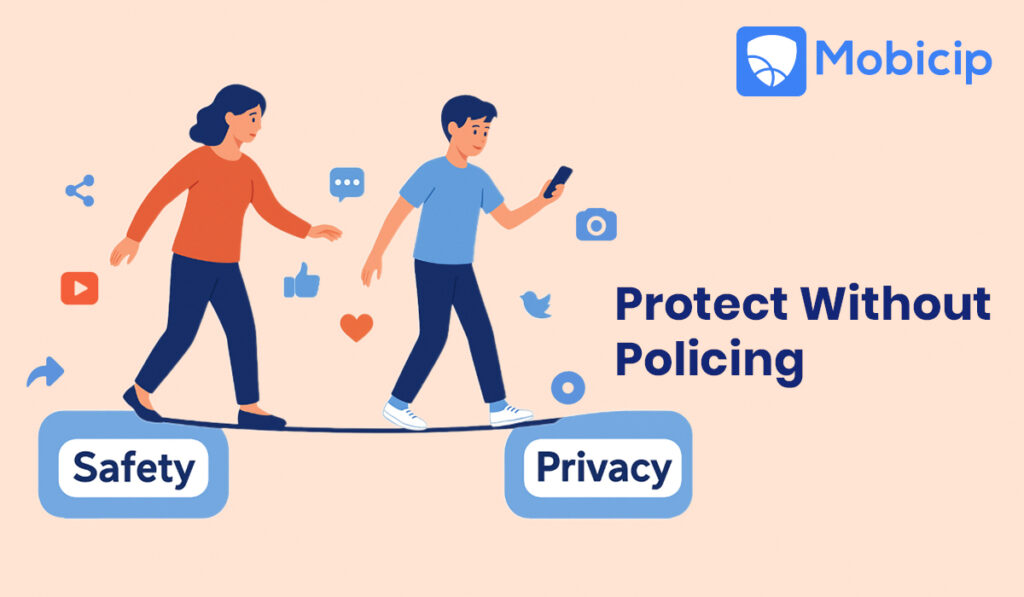Group Chat Gossip: Monitoring Private Messaging Without Invading Privacy

Group chat gossip is not a new concept. According to the Online Etymology Dictionary, the noun “chat” emerged around 1520, initially referring to ‘“’chatter, frivolous talk.’ By the 1570s, it meant ‘familiar conversation,’ and later, in the 1960s, it referred to talk shows. The term ‘chat room,’ referring to online instant communication, appeared in the 1990s.
Today, group chats have taken on an entirely new form. These spaces have become a digital hangout zone for kids and teens, powered by private messaging apps like WhatsApp, Snapchat, Instagram, and Discord. From planning sleepovers to sharing memes—or, unfortunately, gossip and drama—group chats are where much of their social interaction happens.
As parents, this creates a tricky situation. We want to make sure our children are safe, respectful, and mentally well. But how do we strike the right balance between involvement and intrusion? Monitoring private messages without damaging trust is one of the toughest challenges in teen group chat safety. Fortunately, there are smarter approaches—and parental control apps like Mobicip that support open dialogue and constructive monitoring without spying. Let’s explore how we can keep kids safe while still giving them the space they need to grow.
Why Group Chats Can Breed Gossip
The Close-Knit but Complex Nature of Group Chats
Group chats bring together a tight circle of friends who share jokes, plans, and personal stories. This closeness creates a space where information spreads quickly—and not always in a positive way. When everyone hears about something at the same time, rumors and gossip can spread like wildfire.
Constant Connectivity Amplifies Drama
Because group chats are always “on,” messages pile up fast. This constant flow means there’s little time to reflect before reacting, which can lead to impulsive comments or sharing unverified information. A single tease or offhand remark can spiral into gossip before anyone realizes it.
Exclusion Feeds the Rumor Mill
Being left out of a group chat or a specific conversation can feel like a social rejection. When kids notice who’s included and who isn’t, questions and speculations arise. This creates fertile ground for rumors as kids try to make sense of social dynamics or “find out what’s going on” behind the scenes.
Peer Pressure and the Need to Belong
Group chats often pressure members to take sides or go along with the group’s opinions. To stay accepted, kids might repeat gossip or exaggerate stories to fit in, even if they’re uncomfortable doing so. This “pressure to participate” fuels the cycle of gossip and drama.
Private and Unmonitored Spaces Encourage Secrecy
Because group chats happen in private, away from adults or teachers, kids feel freer to share things they wouldn’t say publicly. This privacy makes it easier for gossip to spread unchecked and harder for adults to intervene early.
The Dangers of Group Chat Gossip
“Gossip is the devil’s radio,” George Harrison once said, and in today’s digital world, that radio is set to full volume. Online gossip spreads faster than ever, leaving a lasting mark. Unlike whispered secrets in a school hallway, digital gossip gets typed out, screenshotted, and shared far beyond the original group chat. For kids and teens still learning how to navigate friendships and boundaries, it can quickly snowball into something far more damaging.
Here’s what digital gossip and drama can look like:
- Screenshotting private messages to share with others, often without consent
- Spreading rumors or twisting someone’s words in group chats or DMs
- Exclusion tactics, like making secret side chats to talk about someone or intentionally leaving them out
- Subtle cyberbullying, where sarcastic or cruel comments are disguised as “jokes”
What might seem like harmless drama can deeply affect a child’s mental health. Social media anxiety often stems from constantly checking phones, wondering what others are saying, or fearing they’re being talked about behind their backs. This leads to stress, self-doubt, and a feeling of not being “safe” even in online spaces meant for friends.
The emotional toll can be just as heavy as in-person bullying. In fact, digital words can hurt more because they’re visible, replayable, and permanent.
As parents, recognizing the signs of cyberbullying and being open to honest conversations about online gossip is vital. Kids need support, not shame, when they find themselves caught in the drama—or when they realize they’ve unintentionally added to it.
What Parents Can Do to Prevent Group Chat Gossip Without Spying
You don’t need to read every message or hover over your teen’s shoulder to keep them safe. The secret to monitoring kids online safely lies in building trust, setting clear expectations, and staying alert to potential red flags—without invading their privacy.
Keep Communication Open about the Evils of Group Chat Gossip
- “Who’s in your group chats these days?”
- “Did anything funny or weird happen online today?”
- “Do you ever feel uncomfortable in chats?”
Normalize these conversations early and often, so it doesn’t feel like an interrogation when you bring it up.
Set Expectations for Respect
Just like you teach your kids to be respectful in real life, you can guide how they communicate online. Talk about:
- Being kind, even in disagreements
- Avoiding sarcasm or gossip
- Thinking before they type or share
Clear boundaries help your child recognize the difference between joking and harming, which is crucial in parenting digital teens.
Teach Digital Empathy and Boundaries
Help your child understand that real emotions are behind the screens. Teach them:
- To recognize when someone’s being excluded or hurt
- How to stand up (or step back) in digital drama
- That it’s okay to leave toxic chats or mute groups
Know When to Step In to Stop Group Chat Gossip
You don’t need to be a spy but you do need to be observant. Red flags to watch for:
- Sudden withdrawal from online activities
- Mood swings, irritability, or anxiety tied to phone use
- Hiding screens or becoming secretive about messaging apps
If something feels off, approach with empathy. Ask, listen, and offer help instead of judgment.
By staying engaged and approachable, you can guide screen use while giving your teen the space to learn and grow. It’s all about balance.
When Heavy Monitoring Becomes Necessary
There are times when stepping back just isn’t an option. If your child is showing signs of distress, dealing with online harassment, or facing serious mental health struggles, more active parental intervention may be necessary. Knowing when to monitor teens more closely can make a critical difference.
Watch for online safety red flags like:
- Sudden mood swings, anxiety, or depression
- Refusing to talk about online activity
- Withdrawal from friends or usual interests
- Signs of cyberbullying or harassment in messages or behavior
In these situations, it’s okay to step in—but do it with care. Tell your child you’re concerned, not angry. Explain why you need to get more involved, and let them know this is about keeping them safe, not punishing them.
If the situation is serious, don’t hesitate to involve a therapist, school counselor, or mental health professional. Getting help doesn’t mean you’ve failed as a parent—it means you’re doing the right thing.
Heavy monitoring should never be the first move, but when things escalate, your child needs your protection more than your distance. The key is to act with transparency, compassion, and a long-term goal of rebuilding trust and stability.
Tools to Prevent Destructive Group Chat Gossip
Staying in the loop doesn’t mean scrolling through your child’s chats. With the right tools, you can support online safety for kids while respecting their growing need for independence.
Use a Trusted Parental Control App
Apps like Mobicip offer a balanced approach to digital parenting. You don’t need to read every message—Mobicip helps you guide your child’s screen use without invading their privacy. It’s a tool that empowers parents while building trust with teens.
Key Features of Mobicip
Mobicip lets you monitor usage patterns, set healthy limits, and stay alerted to concerning activity—all without spying. Helpful features include:
- Time limits to prevent overuse and promote balance
- Daily and weekly usage reports to spot patterns and start conversations
- Content filtering to block inappropriate websites and apps
- Activity alerts for flagged content or risky behavior
- App management to see what’s installed and in use

Guide, Don’t Spy
A parental control app is most effective when used as a conversation starter—not a surveillance tool. Let your child know you’ve set up Mobicip and explain why. The goal is to teach digital responsibility, not to control every move.
Used right, tools like Mobicip help you stay informed, connected, and confident in your child’s online world.
Balancing Trust and Safety
Parenting in the digital age works best as a partnership, not a police state. Kids need to know you’re on their team—someone who supports and guides rather than controls every click. Building trust and safety online starts with honest conversations and clear, healthy tech boundaries that everyone agrees on.
When children feel respected, they’re more likely to open up about their online experiences, including any problems they face. Share your concerns without judgment, and listen actively. Use digital parenting tips that encourage teamwork, like setting screen time rules together or discussing what respectful behavior looks like in group chats.
Remember, the goal isn’t to restrict but to empower your child to make smart decisions. When trust is the foundation, safety follows naturally, and your child gains the confidence to navigate the digital world responsibly.
Checklist for Parents to Prevent Group Chat Gossip
Keeping track of all the steps to protect your child online can feel overwhelming. That’s why we’ve put together this quick parenting checklist—easy to follow and flexible enough to fit your family’s unique needs. Use this as a handy reference to help you stay on top of your digital parenting guide.
Set Group Chat Rules
Create clear group chat rules together with your child to encourage respectful and inclusive conversations. Setting expectations early helps prevent misunderstandings and online drama.
Talk About the Dangers of Gossip and Rumors
Discuss the impact of gossip and rumors in the digital world and why spreading them can be harmful. Encourage your child to think twice before sharing or forwarding messages.
Explain the Consequences of Online Behavior
Ensure that your child understands that online actions have real-world consequences for friendships and their reputation. Emphasize accountability and kindness as key values.
Use Parental Control Tools Like Mobicip
Leverage trusted apps like Mobicip to monitor screen time and receive alerts without invading privacy. These tools help guide responsible use rather than spying.
Keep the Conversation about Group Chat Gossip Ongoing
Regularly check in with your child about their online experiences and feelings. Open, ongoing dialogue is the best way to build trust and keep them safe.
Conclusion
Safe messaging apps and thoughtful parenting tools are essential allies in nurturing responsible online behavior. Instead of simply policing every message, parents can foster trust by using solutions like Mobicip that monitor without invading privacy. This approach supports ongoing conversations, allowing kids to learn from their experiences while feeling respected and empowered. IT also helps to have a family technology contract wherein online ethical behaviour is included as a basic rule. Balancing safety with independence helps children grow into confident digital citizens who understand the value of healthy boundaries. Ultimately, the right blend of technology and trust creates a safer, more positive environment for kids to connect, communicate, and thrive online.





